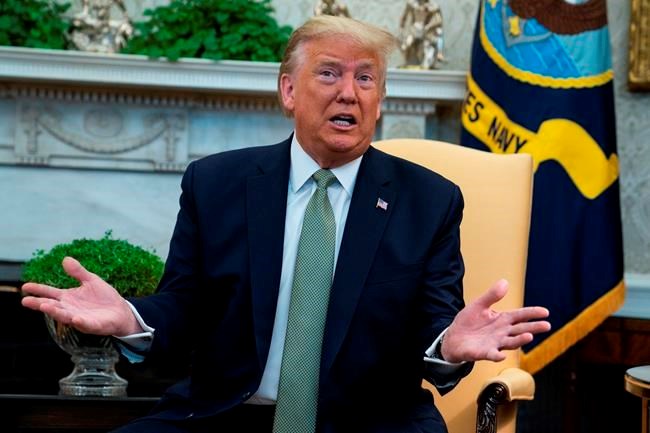WASHINGTON — Donald Trump is closing America's borders to foreign nationals who recently spent time in Europe, a dramatic step that illustrates both the severity of the global outbreak of COVID-19 and the president's tendency towards drastic actions — often involving keeping foreigners off U.S. soil — that raise more questions than they answer. Here are some of the most pressing:
HOW WILL CANADA BE AFFECTED? Within minutes of declaring on national prime-time television that the ban would apply to a "tremendous amount of trade and cargo," the president and the White House were both walking that back, insisting the ban would only apply to relevant foreign nationals — not cargo, U.S. citizens or green-card holders, siblings or children. But the confusion suggests that bottlenecks at the Canada-U.S. border are likely as Customs and Border Protection officials seek to screen out anyone not allowed under the ban. How that could impact the flow of goods between Canada and its largest trading partner remains to be seen. "The American-Canadian border is obviously our priority, and we would want to do everything we can to protect the flow of people and goods on that border," said Goldy Hyder, the CEO of the Canadian Business Council. "All the rules of the game are set aside here."
WHICH COUNTRIES ARE INCLUDED? The affected area involves 26 countries where foreign nationals are allowed to travel freely across borders: Austria, Belgium, the Czech Republic, Denmark, Estonia, Finland, France, Germany, Greece, Hungary, Iceland, Italy, Latvia, Liechtenstein, Lithuania, Luxembourg, Malta, the Netherlands, Norway, Poland, Portugal, Slovakia, Slovenia, Spain, Sweden, and Switzerland. The United Kingdom, the largest source of visitors to the U.S. after Canada and Mexico, is exempt, despite the fact it's a country that's easily reached from continental Europe.
SHOULD CANADA FOLLOW SUIT? It might seem counterintuitive, but if Canada wants to ensure that trade and commerce at the border continues uninterrupted, it could well be an option on the table in what is already uncharted foreign-policy territory. "It’s important that as we look at our responses here that they’re not going to be identical what the Americans do," said Perrin Beatty, president of the Canadian Chamber of Commerce. "But we have to be concerned if we get too great a divergence that suddenly that we find problems on our border and problems doing business with our largest customer."
HOW WILL IT WORK? The ban is scheduled to take effect at midnight Friday night, but will not apply to U.S.-bound travellers who are airborne before the deadline. Members of the U.S. military, certain visa holders, UN officials and others would also be exempt. Anyone not subject to the ban but who nonetheless was in Europe at some point in the last 14 days is to be tested at one of 13 airports across the U.S. upon arrival. Precisely where that screening is to take place was not immediately clear; shortly after the president's address, acting Homeland Security Secretary Chad Wolf issued a statement praising the measure and promising more details about the airports where affected travellers would be directed "in the next 48 hours." Vice-President Mike Pence said Thursday that all Americans and legal residents returning to the U.S. will be asked to self-quarantine for 14 days presumably only if they have been in Europe at some point in the last two weeks. Meanwhile, the U.S. Secretary of State has issued a so-called "Global Level 3" travel advisory, urging U.S. citizens to reconsider their plans to travel abroad.
WILL IT HELP? Critics have been quick to point out that with COVID-19 already spreading in the U.S., where a dismal rate of testing — only 11,000 tests to date, according to reports Thursday out of a briefing on Capitol Hill — has made it difficult to get a bead on the extent of the outbreak, banning travellers from European hotspots seems too little, too late. "We are flying blind," said congressman Mike Quigley, a Democrat from Illinois. And if the measures the president announced Wednesday were designed to calm the markets, they appeared to have the opposite effect: the Dow Jones index was already down by more than eight per cent just before midday.
This report by The Canadian Press was first published March 12, 2020.
— With files from Mike Blanchfield in Ottawa
James McCarten, The Canadian Press


